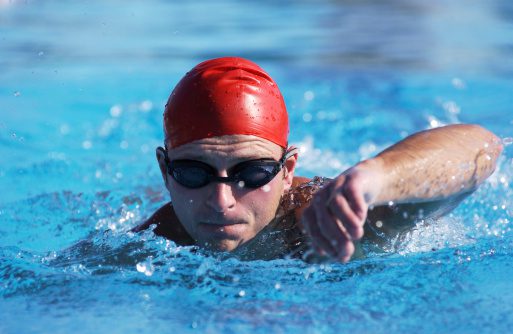Ask the coach: Pool swimming vs. race day swimming

“I notice that my pool times do not translate to my race day times and, that I am slower when I race open water than my intervals in the pool would indicate. What do I have to do to get used to swimming in a pack? Race more?”
Coach’s Response
Some people just seem great at swimming in open water. For others, their fast pool times don’t translate into fast open water swimming. It can be more complex than the lack of lane ropes and a black line to follow.
In my experience, there are two main things that slow people down in open water.
- Getting distracted by your environment and forgetting to focus on swimming. Athletes start thinking about everything else but their stroke: Can I see the buoy? Was that a fish down there? Is anyone around me? What if I hit an underwater obstacle? I can’t see! Where are those buoys? Are my goggles leaking? Anytime you are distracted by external factors, you lose attention to what you are doing, causing a decrease in speed.
- Worrying too much about seeing where you are going, can cause you to sight too much, thereby raising your head too high and often. This sinks your legs and torso, negatively affecting the streamline you’re able to hold so well in the pool as you time trial evenly from wall to reassuring wall.
Both of these habits can be improved with practice in the pool. Do you find yourself losing focus during the middle of longer swim sets? Are you easily distracted in swim sessions? If you are one of those athletes that start wishing for the shower half way through the workout, then chances are you are going to lose focus in open water swimming too. Starting in your pool sessions, set goals at practices that force you to constantly re-focus on “swimming” and swimming well throughout the whole session. This can be as easy as choosing one swim skill to focus on during each interval, using a Tempo Trainer to create an audible reminder to focus on rotation or pull and ignoring irrelevant thoughts (like what you’re going to eat for breakfast).
If you are a sighting-heavy swimmer, you have to change your habit of looking up every other stroke and force yourself to look less. Counting is the best way to regulate this. When swimming open water, only allow yourself to look every 10 strokes (count in your head as you swim) and if you didn’t get a good enough glimpse, force yourself to keep your head down until the next “peek.” This takes a lot of discipline at first for habitual over-sighters, but you can train yourself to look less and trust more. Keep in mind your streamlined swim form from the pool and likely you will soon want to think and look less and swim more.
LifeSport Coach Lucy Smith enjoys coaching athletes of all abilities. She has coached athletes to podium finishes in Ironman (elite and age group), Olympic distance, Triathlon, Duathlon and distance running. Contact Lucy to tackle your first triathlon or to perform at a higher level. Find more tips on Twitter @LifeSportCoach
